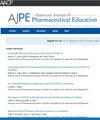一项评估学生药剂师焦虑症患病率的多地点纵向研究。
IF 3.5
4区 教育学
Q1 EDUCATION, SCIENTIFIC DISCIPLINES
引用次数: 0
摘要
目标:在四年制药学博士(PharmD)课程的前三个专业学年(PY1-PY3)中,开展一项基于调查的多站点研究,评估学生药剂师自我报告的焦虑症状的比例:本研究采用横断面观察设计,在华盛顿州立大学药剂与制药科学学院(WSU)和阿肯色医科大学药剂学院(UAMS)进行。我们邀请药学博士课程PY1-PY3 的学生药剂师自愿填写广泛性焦虑症 7 项量表 (GAD-7),以自我报告焦虑程度。GAD-7 是一个经过验证的 7 项量表,采用 4 点李克特量表:在为期五年(2019-2023 年)的时间里,共评估了 2022 份调查问卷,调查对象是西悉尼大学和加州大学洛杉矶分校的PY1-PY3 学生。总体而言,有 882 份(43.6%)完成的调查显示,根据 GAD-7 存在中度至重度焦虑。当被问及工作、处理家中事务或与他人相处的困难时,487 名受访者(24.1%)表示 "非常 "或 "极其 "困难,采用的是李克特 4 点量表:结论:学生的焦虑症状影响了他们的生活活动,似乎需要行为和心理健康方面的支持。药剂学教育者应考虑采取积极主动的方法来改善学生的心理健康,并支持学生药剂师发展与焦虑管理相关的技能。未来的研究可能包括通过有针对性的干预措施来测量学生药剂师焦虑情绪在一段时间内的变化,以及研究确定对报告的焦虑水平的影响。本文章由计算机程序翻译,如有差异,请以英文原文为准。
A Multisite, Longitudinal Study Assessing Prevalence of Anxiety in Student Pharmacists
Objective
Conduct a multisite, survey-based study assessing rates of self-reported anxiety symptoms among student pharmacists enrolled in the first 3 professional years (PY1 to PY3) of a 4-year Doctor of Pharmacy (PharmD) curricula.
Methods
This study followed a cross-sectional observational design conducted at Washington State University, College of Pharmacy and Pharmaceutical Sciences (WSU) and the University of Arkansas for Medical Sciences, College of Pharmacy (UAMS). Student pharmacists in PY1 to PY3 of the PharmD curricula were invited to voluntarily complete the Generalized Anxiety Disorder 7-item (GAD-7) scale in order to self-report measures of anxiety. The GAD-7 is a validated 7-item instrument using a 4-point Likert scale.
Results
A total of 2022 surveys were evaluated from PY1-PY3 students at WSU and UAMS over a 5-year period (2019 to 2023). Overall, 882 (43.6%) completed surveys indicated the presence of moderate to severe anxiety according to the GAD-7. When asked about the difficulty of doing work, taking care of things at home, or getting along with other people, 487 (24.1%) respondents indicated “very” or “extremely” difficult using a 4-point Likert scale.
Conclusion
Behavioral and mental health support appears to be needed to support students living with symptoms of anxiety that are impacting life activities. Pharmacy educators should consider proactive approaches to improve mental well-being and support skill development related to anxiety management for student pharmacists. Future studies may include measuring change in student pharmacist anxiety over time with targeted interventions and studies to determine impact on reported levels of anxiety.
求助全文
通过发布文献求助,成功后即可免费获取论文全文。
去求助
来源期刊
CiteScore
4.30
自引率
15.20%
发文量
114
期刊介绍:
The Journal accepts unsolicited manuscripts that have not been published and are not under consideration for publication elsewhere. The Journal only considers material related to pharmaceutical education for publication. Authors must prepare manuscripts to conform to the Journal style (Author Instructions). All manuscripts are subject to peer review and approval by the editor prior to acceptance for publication. Reviewers are assigned by the editor with the advice of the editorial board as needed. Manuscripts are submitted and processed online (Submit a Manuscript) using Editorial Manager, an online manuscript tracking system that facilitates communication between the editorial office, editor, associate editors, reviewers, and authors.
After a manuscript is accepted, it is scheduled for publication in an upcoming issue of the Journal. All manuscripts are formatted and copyedited, and returned to the author for review and approval of the changes. Approximately 2 weeks prior to publication, the author receives an electronic proof of the article for final review and approval. Authors are not assessed page charges for publication.

 求助内容:
求助内容: 应助结果提醒方式:
应助结果提醒方式:


